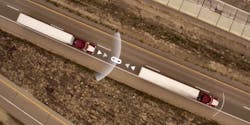LONG BEACH. Platooning technology could offer a major step forward in cutting truck emissions as well as bring significant improvements to highway safety, according to a panel of researchers at the Advanced Clean Technology (ACT) Expo. While the technology is essentially ready, the panel cautioned that achieving those gains faces both regulatory and operational hurdles before platooning can begin to prove its value in real-world fleet use. For at least one major platooning technology developer on the panel, that means holding fleet trials and delivering first production systems to pre-order customers later this year, and ramping up to full volume commercial deployments in 2018.
“All platooning scenarios being considered today offer significant opportunity for fuel and emissions savings in the near future,” said Michael Lammert, a senior engineer with the Dept. of Energy’s National Renewable Energy Laboratory.
Analyzing fleet operational data, the lab estimated that 65% of heavy-duty truck miles could be “platoonable,” that is present conditions when two or more trucks could be paired by the technology to operate closely together at highway speeds. Traffic congestion, scheduling conflicts and “non-driving time” account for the other 35% when platooning would offer no efficiency gains.
If there were high adoption rates for the technology, the DOE lab estimates that running 65% of heavy truck miles in platoon formations would cut overall truck fuel consumption by 4.2%, reducing fuel consumption by 1.5 billion gallons a year, according to Lammert.
A study by the North American Council on Freight Efficiency (NACFE) also predicts a 4% overall improvement in fuel efficiency for highway truck platooning, but cautions that lack of uniformity in state traffic laws present a serious challenge to adoption.
Restrictions on close following distances needed to realize platooning’s fuel savings vary widely from state to state, according to Rick Mihelic, NACFE’s aerodynamic program manager. “They range from no rules at all to a complete tangled mess,” he said during the ACT Expo session. Fleets need predictability before they will invest in platooning systems, which means wide-scale adoption will need “common rules across all 50 states,” Mihelic said.
Not only does truck platooning offer potentially large improvements in fuel consumption and emissions reduction, but it will also improve large-truck safety, according to Steve Boyd, co-founder of Peloton, a company currently developing broad platooning systems that incorporates both on-vehicle and data-management systems.
Two trucks paired in Peloton’s platooning system require both drivers to remain fully engaged in braking and steering their individual vehicles. However, automated emergency braking systems and fast vehicle-to-vehicle (V2V) communications reduces braking application in both trucks from 1.5 seconds for a driver to 0.03 seconds for the automated system, according to Boyd. Pelaton’s system analyzes each truck’s actual performance characteristics before matching two vehicles in a platoon, always assigning the one with the longer stopping distance to the lead position. Dynamic geofencing that monitors external conditions such as traffic, weather and mountain grades also contribute to safer truck operations in platooning mode, he said.
The major operational challenge for platooning is identifying two trucks going in the same direction at the same time. The ACT Expo panelists agreed that early adopters will most likely be large LTL fleets that can match their own tractors moving between terminals, but that broad use of platooning will require some way to pair vehicles across multiple fleets. The issues there include mutual trust that potential partners are operating and maintaining vehicles to high safety standards, deciding who takes the lead position with its significantly lower economy advantage, as well as potentially sharing route data with competitors.
Boyd said that Pelaton has recently signed an agreement with the telematics provider OmniTracs to develop a system that will facilitate cross-fleet platooning. “Truckload carriers in particular don’t often have trucks together on the same routes, so they’re really looking to use cross-fleet pairing as a way to access to platooning gains,” Boyd said. “And pricing [for the platooning service] could be adjusted for that front truck with the lower fuel efficiency.”
About the Author
Jim Mele
Jim Mele is a former longtime editor-in-chief of FleetOwner. He joined the magazine in 1986 and served as chief editor from 1999 to 2017.
